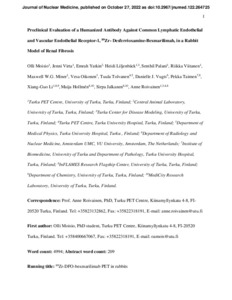Preclinical Evaluation of a Humanized Antibody Against Common Lymphatic Endothelial and Vascular Endothelial Receptor-1, 89Zr-Desferrioxamine-Bexmarilimab, in a Rabbit Model of Renal Fibrosis
Moisio Olli; Virta Jenni; Yatkin Emrah; Liljenbäck Heidi; Palani Senthil; Viitanen Riikka; Miner Maxwell WG; Oikonen Vesa; Tolvanen Tuula; Vugts Danielle J; Taimen Pekka; Li Xiang-Guo; Hollmén Maija; Jalkanen Sirpa; Roivainen Anne
https://urn.fi/URN:NBN:fi-fe202301173192
Tiivistelmä
Bexmarilimab is a new humanized monoclonal antibody against common lymphatic endothelial and vascular endothelial receptor-1 (CLEVER-1), and is in clinical trials for macrophage-guided cancer immunotherapy. In addition to cancer, CLEVER-1 is also associated with fibrosis. To facilitate prospective human PET studies, we preclinically evaluated 89Zr-labeled bexmarilimab in rabbits.
Methods: Bexmarilimab was conjugated with desferrioxamine (DFO) and radiolabeled with 89Zr. Retained immunoreactivity was confirmed by flow cytometry. Distribution kinetics of intravenously administered 89Zr-DFO-bexmarilimab (0.1 mg/kg) for up to 7 days in a rabbit model of renal fibrosis mediated by unilateral ureteric obstruction (UUO). The in-vivo stability of 89Zr-DFO-bexmarilimab was evaluated by sodium dodecyl sulfate-polyacrylamide gel electrophoresis in combination with autoradiography. Additionally, we estimated the human radiation dose from data obtained in healthy rabbits.
Results: 89Zr-DFO-bexmarilimab cleared rapidly from the blood circulation and distributed to the liver and spleen. At 24 hours post-injection, PET/CT, ex-vivo gamma counting and autoradiography demonstrated that there was significantly higher 89Zr-DFO-bexmarilimab uptake in UUO-operated fibrotic renal cortex, characterized by abundant CLEVER-1-positive cells, than in contralateral or healthy kidneys. The estimated effective dose for a 70-kg human was 0.70 mSv/MBq.
Conclusion: The characteristics of 89Zr-DFO-bexmarilimab support future human PET studies to, for example, stratify patients for bexmarilimab treatment, evaluate the efficacy of treatment, or monitor disease progression.
Kokoelmat
- Rinnakkaistallenteet [27094]
